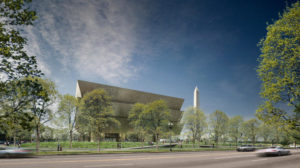
Exterior architectural rendering of the forthcoming National Museum of African American History and Culture. (Freelon Adjaye Bond/Smith Group)
When the Smithsonian’s National Museum of African American History and Culture finally opens in 2016, visitors will be able to see a huge number of historical artifacts, including everything from Emmett Till’s casket to Muhammad Ali’s boxing gloves. Founding Director Lonnie Bunch said the museum takes a “warts and all” approach to Black history, showcasing even the more uncomfortable parts.
“I don’t think America is ever ready to have the conversation around race based on what we see around the landscape, whether it’s Ferguson or other places, that people are really ready to shine the light on all the dark corners of the American experience. But I hope this museum will help in a small way to do that,” Bunch told Sixty Minutes. ”This is not the Museum of Tragedy. It is not the Museum of Difficult Moments. It is the museum that says, ‘Here is a balanced history of America that allows us to cry and smile.’”
Plans for a national museum honoring Black people’s contribution to American history were first started in the early 20th century by a group of Black veterans upset with the racism they experienced visiting Washington, D.C. President Herbert Hoover appointed a commission to study building a Black history museum, but plans were stalled in Congress for several decades. In 2001 legislation by Reps. J.C. Watts and John Lewis kickstarted plans for the national Black history museum. In 2003, President George W. Bush signed legislation officially creating the museum. According to 60 Minutes, Congress approved $250 million for its construction and Bunch has raised another $250 million.
Bunch told 60 Minutes’ Scott Pelley it was important the museum was located in D.C.
“I knew that this is where this museum would have to be. That this is America’s front lawn and this is the place where people come to learn what it means to be an American and this museum needs to be there,” Bunch said.
The museum will contain thousands of historical artifacts which were painstakingly gathered, restored and recorded by Smithsonian staff. Sixty Minutes said 3,000 people brought family heirlooms to 16 Smithsonian events across the country. Some of the artifacts are large objects such as a crop duster used to train the Tuskegee Airmen, the guard tower at the notorious Angola prison and a segregated rail car, which was broken down, transported to DC by truck and lowered into the building by a crane.
Architect David Adjaye told Al Jazeera the building’s design will reflect the African influence on Black culture.
“Well, I think that you look for important flashpoints in the story that have a very powerful resonance,” Adjaye said. “For instance, just looking back at the history, thinking about the great artistic periods of West Africa. The Yoruba were one of the great kingdoms of that time. And looking at what would have been iconographic to people of that time or what would have been special or the magical thing, the temples of that time. We try to imagine that.”
Adjaye said he hoped visitors to the museum will understand Black people played an important role in the development and construction of America. Black history is American history.
“I think that what the world will see is that the African-American story is not a footnote but probably the lens to really understand America, to this day,” Adjaye said. “I mean, I don’t know about America in the future. But I think that the African-American experience has been part of the commercial success of America but also the extraordinary progress and modernity of America in terms of its laws, its understanding, that even though this has been seen as a bit of an evil, it’s also been an extraordinary sort of refiner of an important, you know, the most important superpower in the world, the kind of leader of the world, to really show the world about how struggle can also create emancipations.”


